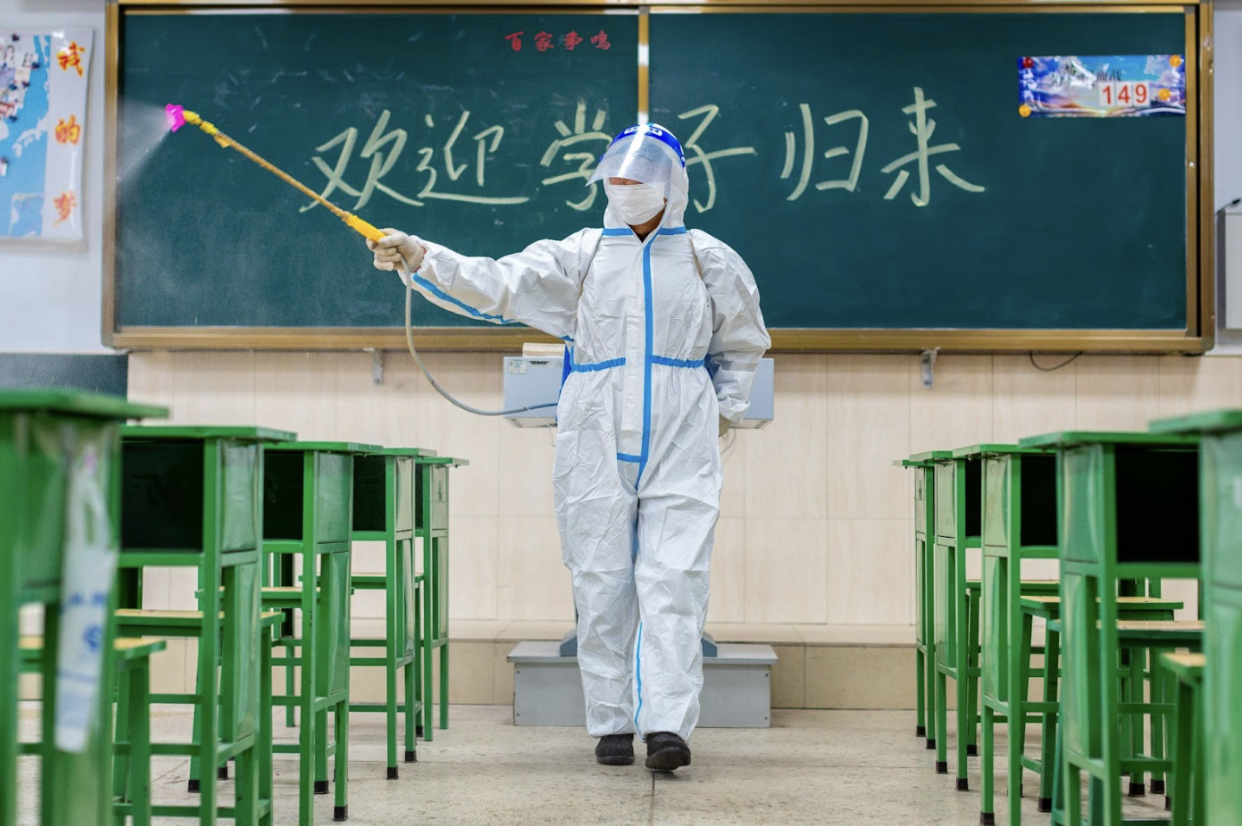China’s local governments are struggling to pay their bills
Provincial- and city-level governments in China are straining under unsustainable debt habits decades in the making, which were exacerbated by the costs of COVID-zero. Teachers and other public service employees are paying the price.

Last September, 29-year-old graduate Alex Xu began her first day as an English teacher at a public elementary school in Shenzhen, one of the richest cities in the economic powerhouse of southern China. She was happy with her promised salary of around 11,000 yuan ($1,600) per month and around 12 weeks of vacation every year.
She was paid the promised salary for the first two months, but in the third month, she received only 1,400 yuan (about $200). The school explained that the shortfall was due to a one-time deduction of social security costs. But she doubted the explanation: “Everyone is guessing that the government is out of money,” Ms. Xu said.
Ms. Xu was paid normally for her fourth month of work, but expressed her concern about another paycheck deduction, stating that she would leave Shenzhen and return to hometown if her salary dropped below 10,000 yuan ($1,500) a month.
Li Meng, a teacher at a public middle school in Shenzhen, had his salary reduced by one-third during the outbreak without any public explanation. “I wouldn’t recommend anyone become a teacher in Shenzhen anymore,” he said, “House prices are too high, and the salary is too low.”
The Shenzhen teachers’ complaints are just two examples of the strains in local government financing that are being talked about all over the Chinese internet, and sometimes even on the streets: Last week, pensioners in the cities of Dalian and Wuhan protested against cuts to their government health insurance, and there have been rumors and reports around the country of other tightening measures such as rationing of natural gas and heating services and cuts to bus services.
COVID-zero costs and the collapse of land sales
Before the abrupt end of the COVID-zero policy in December, massive lockdowns and testing consumed local government budgets. The collapse of the real estate market during the pandemic also drained the coffers of local governments. Provinces across the country are now struggling with mounting debt.
The government said as much on January 8, when state news agency Xinhua published an article on the “new stage” of epidemic prevention, in other words, the reopening and end of COVID-zero, noting that it was “difficult to eliminate the coronavirus, and the social and financial costs of epidemic prevention were growing.”
It’s not yet clear how high those costs were, but Guangdong — the most economically important province in the country with an estimated GDP in 2022 of 12.9 trillion yuan ($1.9 trillion) — spent $22 billion fighting COVID in the past three years. The spending increased by about 50% every year and peaked at $10.6 billion in 2022, according to the provincial annual budget report published last month.
Aside from the costs of COVID-zero but related to it, another key factor contributing to this lackluster performance is the downturn in the real estate market, which led to a slump in land sales incomes, a major source of revenue for local governments, accounting for over 30% of their total income.
“From the second half of 2021, China experienced a rapid decline in property prices and home sales,” Vice-Premier Liú Hè 刘鹤 said at the World Economic Forum’s annual meeting in Davos last month. “If not handled properly, risks in the housing sector are likely to trigger systemic risks.”
In 2022, China’s sales of commercial housing fell by 26.7% compared to the previous year, hitting a new six-year low. Home prices have dropped for 16 consecutive months. Government revenue, which mainly relies on land sales, has fallen by double digits in at least 27 out of China’s 34 provinces.
And while the end of COVID-zero did lead to a bounce back of consumer spending — over 300 million tourists spent a total of $56 billion during the 7-day Lunar New Year holiday in January — Chinese families are much more cautious about buying houses.
According to data from a Chinese real estate research company, the real estate sales volume of the top 100 largest developers in China decreased by 32% in January. In the country’s 30 largest cities, real estate sales were only at 60% of the 2022 level.
People no longer believe that housing prices will keep going up, many have lost the drive to take out loans to buy homes. Anne Stevenson-Yang, co-founder J Capital Research, told The China Project: “The key thing is that nobody is starting new real estate projects, because they have no confidence that they can sell them.”
The result of all this: China’s GDP growth in 2022 is estimated to have been about 3%, the worst since 1976 (apart from 2020’s 2.2%), when the Chinese economy shrank by 1.6% after the death of Máo Zédōng 毛泽东.
The cost of eliminating the pandemic placed extraordinary pressure on local finances, pushing governments to cut spending across the board to support COVID prevention work. For example, in 2022 in Longgang District of Shenzhen, Guangdong Province, where Ms. Xu resides, the authorities retracted 760 million yuan ($111 million) in previously allocated funds for civil servant bonuses, retiree pensions, and electricity subsidies last year, and redirected them towards COVID prevention and control efforts such as nucleic acid testing and vaccination expenses.
Other cities have also responded by cutting or reallocating spending. Hebei citizens had trouble cooking and heating this winter, due to the lack of government subsidies. Several southern cities have suspended their bus services, which the bus companies attribute to the budget constraints of government subsidies. Several developed eastern provinces cut public service sector em employee wages by 30% in 2022, according to respected Chinese news media Caixint (the article was later deleted from their website.)
“Developed regions’ civil servants not receiving full salaries is rare,” Victor Shih, a Chinese politics and fiscal policy scholar at the University of California, San Diego told The China Project. “This indicates that the financial revenue of China’s local governments deteriorated significantly last year.”
New fuel for a slow-burn debt crisis
The financial troubles of the last three years have added to a long-burgeoning debt crisis for local governments across China. Aside from selling land, in the mid-1990s, local governments began to raise funds by setting up local government financing vehicles (LGFVs, 地方政府融资平台) and borrowing money.
Since the 2008 financial crisis, local government debt in China has risen significantly, and in the past three years, local governments have issued a record amount of new bonds to cope with pandemic expenses. According to data from the Ministry of Finance, as of the end of December 2022, the balance of local government debt in China exceeded 35 trillion yuan ($5.08 trillion), an increase of 14 trillion yuan ($2.03 trillion) from the end of 2019, and more than double the amount from the end of 2014.
There are also debts that are not reported on the balance sheet, which some research firms say could be much larger than the reported data.
There are mixed signals from the government. In January, the minister of financeLiú Kūn 刘昆 stated that the debt-to-GDP ratio of China’s government debt is currently below the international alert line of 60%, and the overall risk is controllable. However, former finance minister Lóu Jìwěi 楼继伟 wrote in February 2021 that during the 14th Five-Year Plan period (2021-2025), around a quarter of provincial-level finances will use more than 50% of their revenue to pay off debt.
“The issue of local government debt not only affects the ability of local governments to provide public services, but also accumulates financial risks,” Lou wrote.
“They won’t keep deducting our salaries, right?” She said,” After all, if Shenzhen can’t make it, then China’s economy is done for.'”






